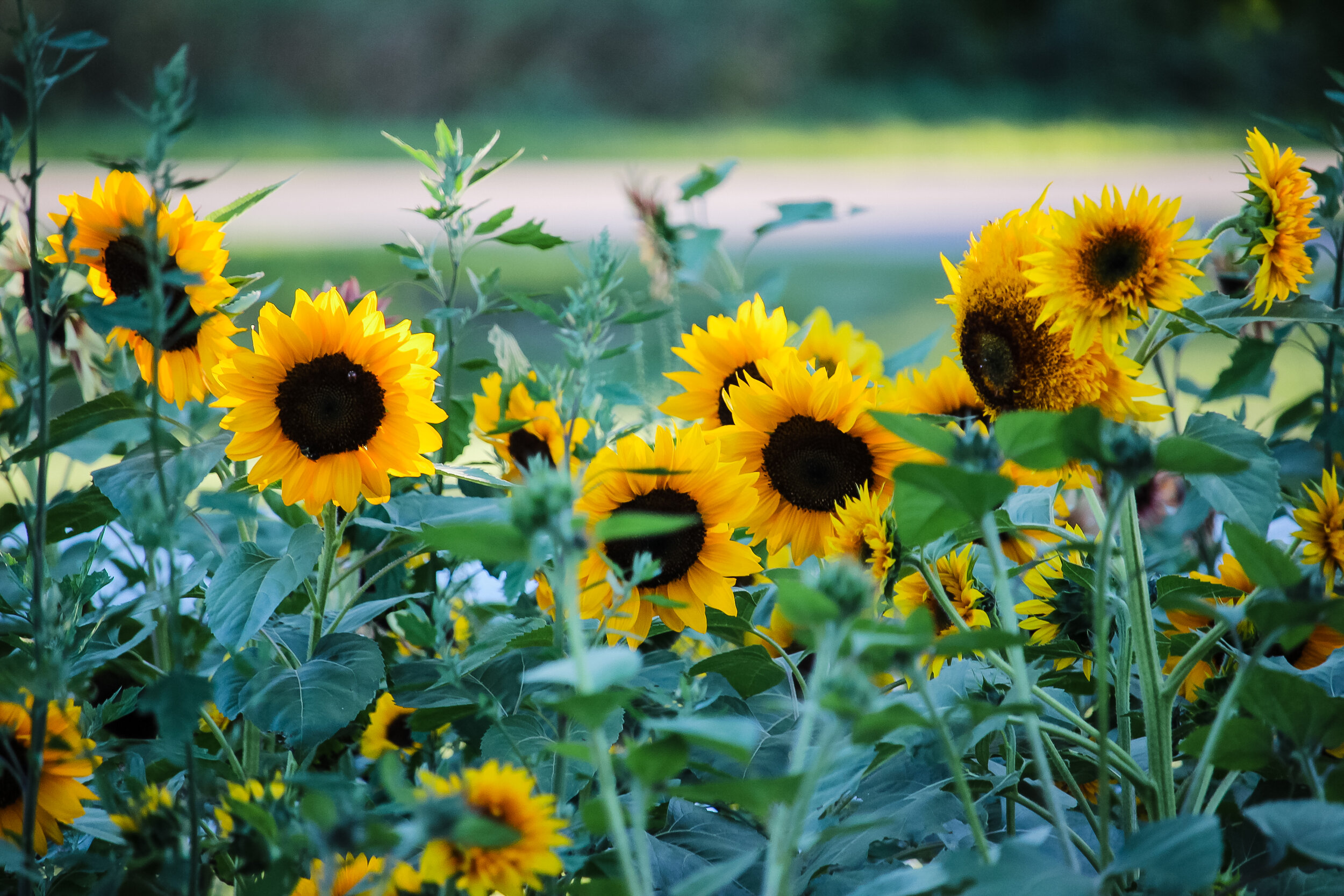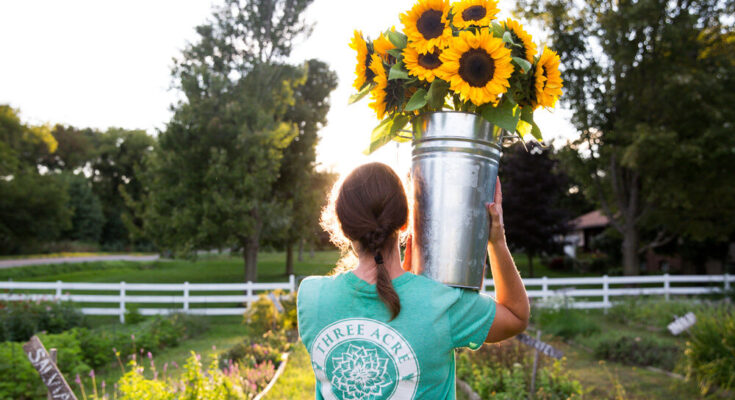Sunflowers. Does anything shout “Summer!!!!” more than bright, sunny sunflowers?!?

They are eternally cheerful and loved by many…. Including our animal friends. Birds and bees adore sunflowers as a source of pollen and seeds. Be sure to plant a few extra just for them!
Years ago, I planted several different types of sunflowers in my vegetable garden to attract pollinators. The next spring, I noticed sunflowers sprouting all over the garden. How about that! The birds had sowed the seeds for me! I let them grow and watched all the beautiful flowers grow, and feed the birds… and this cycle continues today.

I grow lots of sunflowers to harvest for cut flower use, but I always leave all the ones in my vegetable garden for the birds and the bees 😉
Let’s look at the Pros and Cons of growing Sunflowers for cut flower use.
PROS
-
They come in a multitude of colors and sizes, from 2 foot tall dwarf varieties to 12 foot tall Mammoth varieties.
-
They are easy to grow, perhaps the easiest of all flowers.
-
They provide pollen for pollinators (honeybees, bumblebees, butterflies, etc.)… unless you purchase “pollenless” varieties.
-
They are bright and cheerful in bouquets.
-
They have a good vase life of 5 -7 days, with proper harvest and care.
CONS
-
They are a “once and done” type plant, meaning once they bloom, they are finished and will not bloom again.
-
They tend to muck up the vase water quickly.
-
They transition from “not quite ready” to harvest to “too late!” very quickly… sometimes in just hours.
-
They don’t last long in the vase if you allow the flowers to be pollinated.

CHOOSING SEEDS
There are so many different Sunflowers to choose from. It can feel very overwhelming, so let’s break it down a bit.
It’s important to know:
1. Not all Sunflower varieties make good cut flowers. When you see photos of HUGE sunflower fields, those are usually sunflowers grown for bird seed or sunflower oil. These do not make good cut flowers.
You want to look for “Ornamental” sunflowers. This is the kind you will find in most gardening seed catalogs. Some types are better than others for cut flower use.
2. Ornamental Sunflowers can be divided into 2 main categories:
Single Stem: This type produces one flower on one stem.
-
Once the bloom as been harvested, it will not send up another bloom.
-
Some are available as “pollenless”. This is helpful for people with allergies.
-
They grow extremely fast, some varieties going from seed to bloom in 55 days!
-
Because they are a “once and done” type flower, you will need to plant new seeds every 10-14 days May – August if you want blooms all summer into fall.
Branching: This type will send out multiple blooms. The blooms will mature over a few weeks, extending the bloom time of the plant.
-
Most sunflower grown for garden or decorative use are Branching varieties.
-
The stems are often too short to make a good cut flower (unless you “pinch” the plants very early in their growth… I’ll show you how to do it under the “Growing On” section)
-
Even though they produce multiple blooms, you will still need to plant new seeds about every 2-3 weeks May – August if you want blooms all summer.
Here are a few of my favorite Sunflowers to grow for cut flower use:
-
“ProCut Orange” (single stem)
-
“ProCut Gold” (single stem)
-
“ProCut Plum” (single stem)
-
“ProCut Brilliance” (single stem)
-
“Sunrich Summer Provence” (single stem)
-
“Vincent’s Choice” (single stem)
-
“Cherry Rose” (branching)
-
“Autumn Beauty” (branching)
-
“Soraya” (branching)
-
“Starburst Panache” (branching)
-
“Starburst Lemon Aura” (branching)
-
“Strawberry Blonde” (branching)
Click here to see where I purchase seeds.
HOW TO SOW
Sunflowers are heat loving, summer blooming flowers.
Here in Michigan, our last spring frost is about May 15, so we wait until that date to sow our first round of seeds. Depending on the variety and the soil temperature, we can expect to see blooms in 50-90 days – late June to mid July.
Transplants or Direct Sow?
Sunflowers are very forgiving and can be transplanted or direct sown.
If you have problems with birds, squirrels or chipmunks, you may want to start the seeds indoors as transplants to prevent the seeds from being gobbled up! Don’t worry – the seeds grow FAST and will be ready to transplant out in less than 2 weeks. Do not leave them in the seed trays for much longer than that.
You can also direct sow the seeds. It really couldn’t be easier. Poke a hole with your finger, drop in 2 seeds (in case one doesn’t germinate), cover the hole and you’re done. Thin to one plant per hole if they both germinate.
PLANT SPACING
For Single Stem Sunflowers: Plants should be spaced 4-9” apart. I usually do 6” spacing. The closer the plants are spaced, the smaller the blooms will be, which is more desirable for bouquets. Plants spaced farther apart will produce larger blooms.
For Branching Sunflowers: Plants should be placed 12”-24” apart. I usually do 18” spacing.
GROWING ON
Sunflowers are quite tolerant of most soil types and will thrive without much fuss.
For Branching Sunflowers ONLY: Branching sunflowers are capable of producing multiple long stemmed blooms per plant IF THEY ARE PINCHED.
Plants that are not pinched usually produce many blooms, but the stems are so short and thick, it renders them unusable for cut flower use.
In contrast, pinched plant can produce 6-10 long stemmed blooms that are perfect for cut flower use. 10 blooms from 1 seed! That is an incredible ROI (Return on Investment)!

Pinching MUST take place early in their growth, when the plants are about 8”-12” tall (less than knee high). Pinching alters the growth habit of the plant, causing all the stems to originate from one point on the plant.
To pinch, simply locate the central bud on the plant (it will be tiny, less than the size of a pea) and dig it out with your thumbnail. That’s it!
DO NOT PINCH SINGLE STEM SUNFLOWERS.

STAGE OF HARVEST
We’ve all oooh and aaahed over those gorgeous photos of sunflower fields…. But did you know sunflowers grown for cut flower use actually need to be harvested BEFORE they open?
Yup. That’s right. BEFORE they open up, BEFORE you can see their pretty faces.
If you miss harvesting them at the ideal stage, you can still harvest as long as the petals are pointing forward, not back (knowing they won’t last as long in the vase as blooms cut at the ideal stage). Once they are pointing back, you might as well leave them for the bees and the birds.
As you can see in the photo below, these sunflower blooms all blew open faster than we could harvest! We got a day of rain… and then they all opened up in the span of a few hours. While some were too far gone to harvest (and now worthless to me), they sure looked nice in the field!

Pictured below is a bloom that I would consider too far gone to harvest (especially because it has insect damage). I left this one for the birds!

The one pictured below is at the ideal stage of harvest. For the longest vase life, you want to harvest the stem when you notice a few petals starting to lift off the face.

Cut the stems about 24” deep and strip off nearly all the foliage (you can allow a few leaves to remain at the top, if desired).
When Sunflowers are cut at this stage, you will get a much longer vase life. The flower will open fully over the next day or 2.
POST HARVEST CARE
If you are displaying the Sunflowers immediately, no special treatment is needed, besides allowing them to rest in a cool, dark area for a few hours.
However, if you want to store them for later (because they all tend to be ready at once!), you can place them in a cooler or refrigerator for about a week. This will delay opening. Once removed from cold storage, the blooms will open up naturally.

Sunflower are a somewhat “dirty flower”. They tend to make the water get gross. Dirty water breeds bacteria, the enemy of cut flowers. Bacteria significantly reduces vase life.
To combat this, it’s important to change the water at least once a day or use commercial flower food (easily found on Amazon – I like “Floralife”).



